Delidding The AMD Ryzen 5 2400G APU: How To Guide and Results
by Gavin Bonshor on May 10, 2018 8:00 AM EST- Posted in
- CPUs
- Guides
- APUs
- Ryzen
- Ryzen 3 2200G
- Ryzen 5 2400G
- Delidding
- Delid
Delidding The Ryzen 5 2400G Results and Conclusion
There has been a lot of hype since the launch of the Ryzen 2000 series APUs and in our Ryzen 5 2400G review, it’s noted that in multiple scenarios they outperform the competing Intel counterparts second to none in pixel rendering tests such as gaming, mainly thanks in no small part to the integrated iGPU featuring Vega cores. The aim of today’s testing with our best Ryzen 2000 series APU from a purely CPU frequency-based standpoint was to ascertain whether delidding makes a noticeable improvement to thermal performance, as well as determining if any extra headroom in CPU core frequency is made available.
As per our regular motherboard testing methodology when we find the max stable overclock, testing was done following the same procedure. Following on from the testing done in our Ryzen 2000 series APU overclocking guide, the aim in this was to continue with simple overclocking to push the core frequency.
To start, here are our initial overclocking results with the retail chip as sold:
After delidding the chip, replacing the paste with a liquid metal TIM, we achieved the following results:
Not only are the thermal properties improved from delidding and having the IHS slavered up with Thermal Grizzly Conductonaut liquid metal compound but operating at the previously unstable frequency of 4.2 GHz was made possible after delidding. Even at 4.2 GHz with the 2400G delidded, the temperatures hit the same levels as 4.0 GHz non delidded which is quite impressive. Even more monumental was the system managed to boot into Windows 10 at a clock speed of 4.3 GHz, although the system wouldn’t just hang when OCCT was fired up, it would crash completely meaning that even with a good AIO CPU cooler and being de-lidded, no more than 4.2 GHz was stable with this particular chip.
The best way to represent some of this data is in graphs. First up is the main one, temperature:
This is a clear representation showing the decrease in CPU temperature after the delidding process. The higher the frequency, the bigger the overall difference!
For power consumption, there was almost zero difference. This is to be expected: the chip will still consume the same amount of power with a standard temperature window. The cooler still has to remove the heat energy, however it is now being transferred better to the cooler through the new TIM.
The interesting result here is POV-Ray. We use POV-Ray in our overclock testing as it is usually very good if there are cache and memory errors associated with the high frequency. However here we see that beyond about 3.8 GHz, the retail processor has trouble getting more performance at a higher frequency, likely due to the CPU reaching thermal limits and the frequency mechanisms having to compensate. The end result is 'sustained' performance at higher frequencies. Due to the delid process, this was not an issue through to 4.2 GHz. Having the extra thermal headroom ultimately gave both more frequency and better sustained performance.
Is Delidding the Ryzen 2400G Worth it? Risk Versus Reward
As previously stated, the primary use where I could see delidding a Ryzen 2000 series APU viably applicable would be in a situation where cooling restrictions are in place such as a small form factor system or a HTPC. The benefits of the reduction in temperature would allow for a more svelte and slim line cooler to be used without pushing towards the maximum operating temperature.
Another less but pertinent use would be for performance users wanting faster clock speeds, although at a cost of voiding the warranty, potentially damaging and killing the chip itself during the process, and the added cost of the tools, it could be a price too much in retrospective which could be spent on a better CPU to begin with. Some vendors in the EU such as Caseking are actually selling pre-delidded Ryzen 3 2200G and Ryzen 5 2400G chips with their own warranties at an additional cost, which is often a better idea than manually performing the process and shelling out for the extra tools. That’s all good, providing this option is available to the user, although so far, I have yet to be able to find a large vendor offering this service in the US.


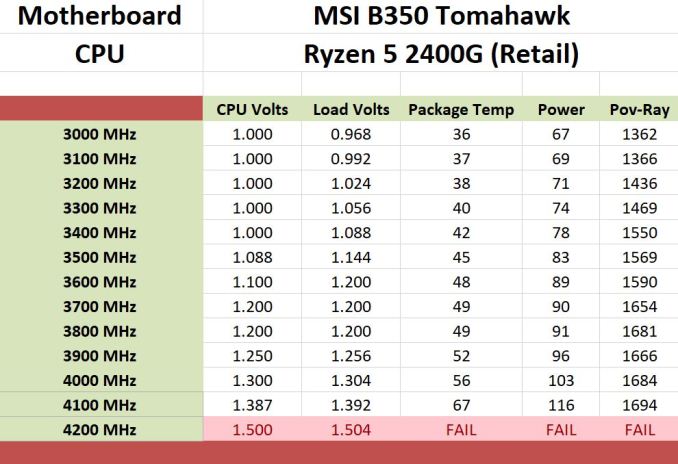
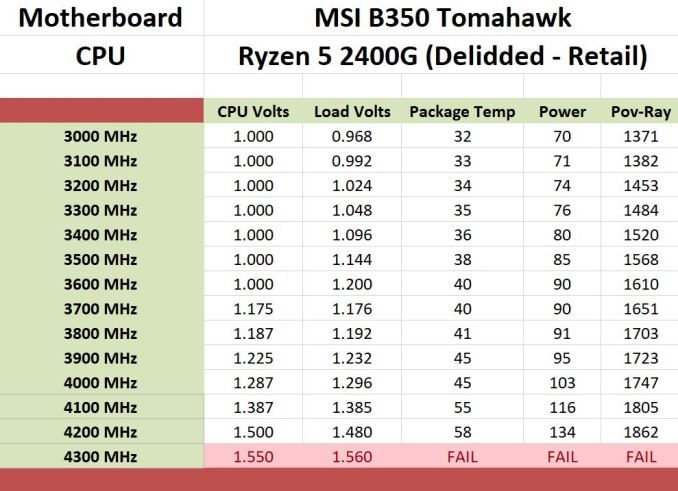
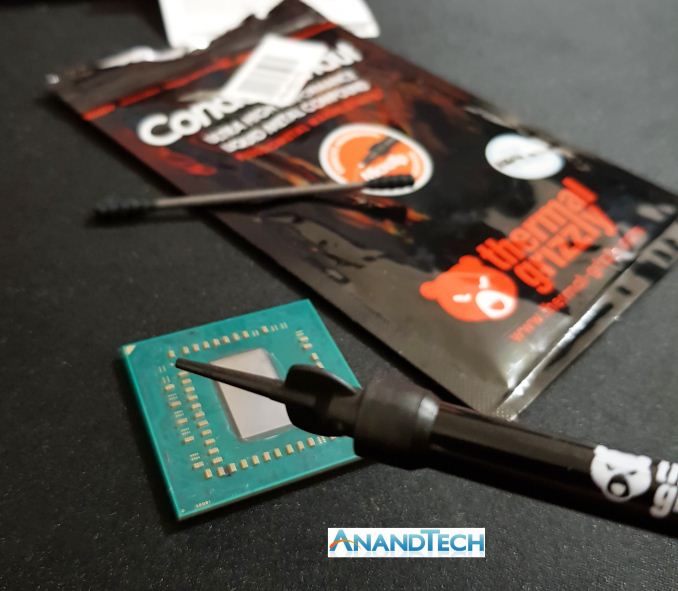
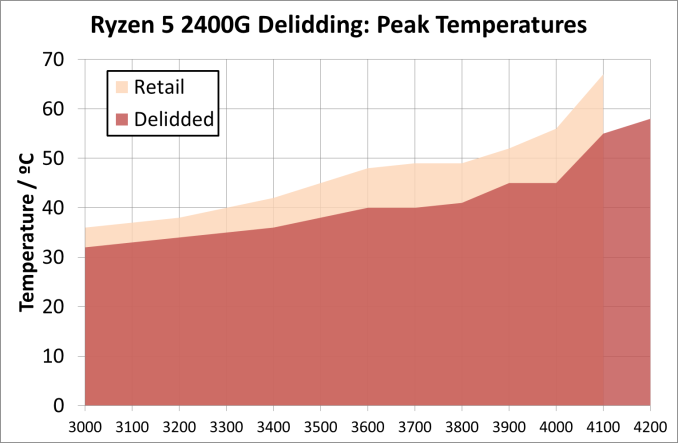

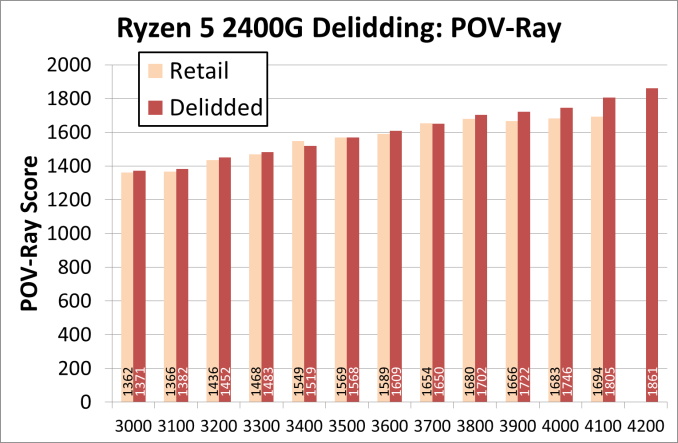








73 Comments
View All Comments
MDD1963 - Thursday, May 10, 2018 - link
100 more MHz! Great Scott...!!!!!!!!!!!!!!!!! :/PeachNCream - Friday, May 11, 2018 - link
Yeah, it does seem like a lot of effort and cost for a minimal reward. In fact, taking the results at face value -- the CPU was already operating at a reasonable temperature under load and the performance increase was insignificant given the risks. However, there's more to this effort that we haven't seen yet like the upcoming iGPU results. I'm curious about what's to come.I would like to see fewer silly screen names on products though. It's hard to take a name like Der8auer with a glaringly obtuse number in it very seriously. When I was a teenager, I remember seeing children calling themselves "sk8ters" and I thought it was stupid back then. It looks even more ridiculous now that I'm getting older. Maybe someday there'll be another segment of the PC hardware market that forks off the LED and screen name festooned man-child branch that is understated yet still premium.
AntonErtl - Thursday, May 10, 2018 - link
Nice Article, thanks.About relidding: You already reduce the clearance by removing the glue. Ok, so you need a naked-die-mount if you leave the heat spreader away, but why not go all the way when you already went this far? And it would eliminate the worry that the heat spreader is inadvertently moved in a bad way.
Maybe stuff for a future article? How are temperatures affected by naked-die-mounting relative to relidding?
sor - Thursday, May 10, 2018 - link
Yeah I was wondering about that as well. It used to be the norm from factory. I’m sure it’s common knowledge among enthusiasts who do this sort of thing regularly.vext - Friday, May 11, 2018 - link
The included Ryzen mounting system uses springs, which have a spring rate. If you remove the spreader, you change the CPU stack height, and lower the clamping force. So you have to somehow modify the mount, with heavier springs or shims behind the springs, or install a shim to increase the CPU stack height again.Other mounting systems have their own issues, which may be easier to modify.
sor - Friday, May 11, 2018 - link
I’m not convinced. I’d be more willing to believe that maybe it causes the heat sink to not clear a motherboard or socket component. There’s a decent amount of pressure on that heatsink clip and I doubt it’s going to notice such a small variance.sor - Friday, May 11, 2018 - link
Also, given the complexity of this mod it seems strange that a spring loading issue would stop you from getting the lid out of the way. If that were a problem, after all the trouble of delidding and using special paste surely they’d be able to figure out how to slide a toothpick under the spring clip.boozed - Thursday, May 10, 2018 - link
A hammer and a bad habit you say?sonny73n - Thursday, May 10, 2018 - link
Why did you have the lid back on after going thru troubles of delidding?sor - Thursday, May 10, 2018 - link
I remember all the old Athlons (e.g. the venerable “Barton” core) basically came delidded in the retail box and your heat sink went straight on top. I can understand why AMD and Intel started putting lids on, but it seems weird to me that one would go to the trouble to delid and then put the lid back on. Certainly heatsinks scan still be screwed down to make up the difference in thickness. Is it because these sockets don’t balance pressure across the die as well?